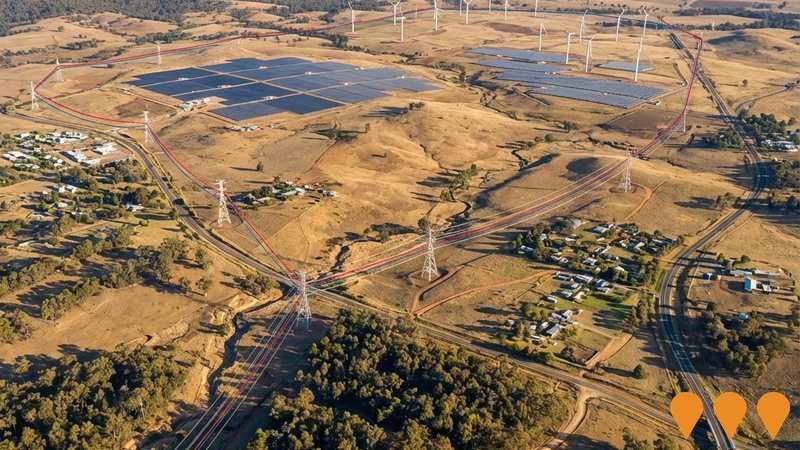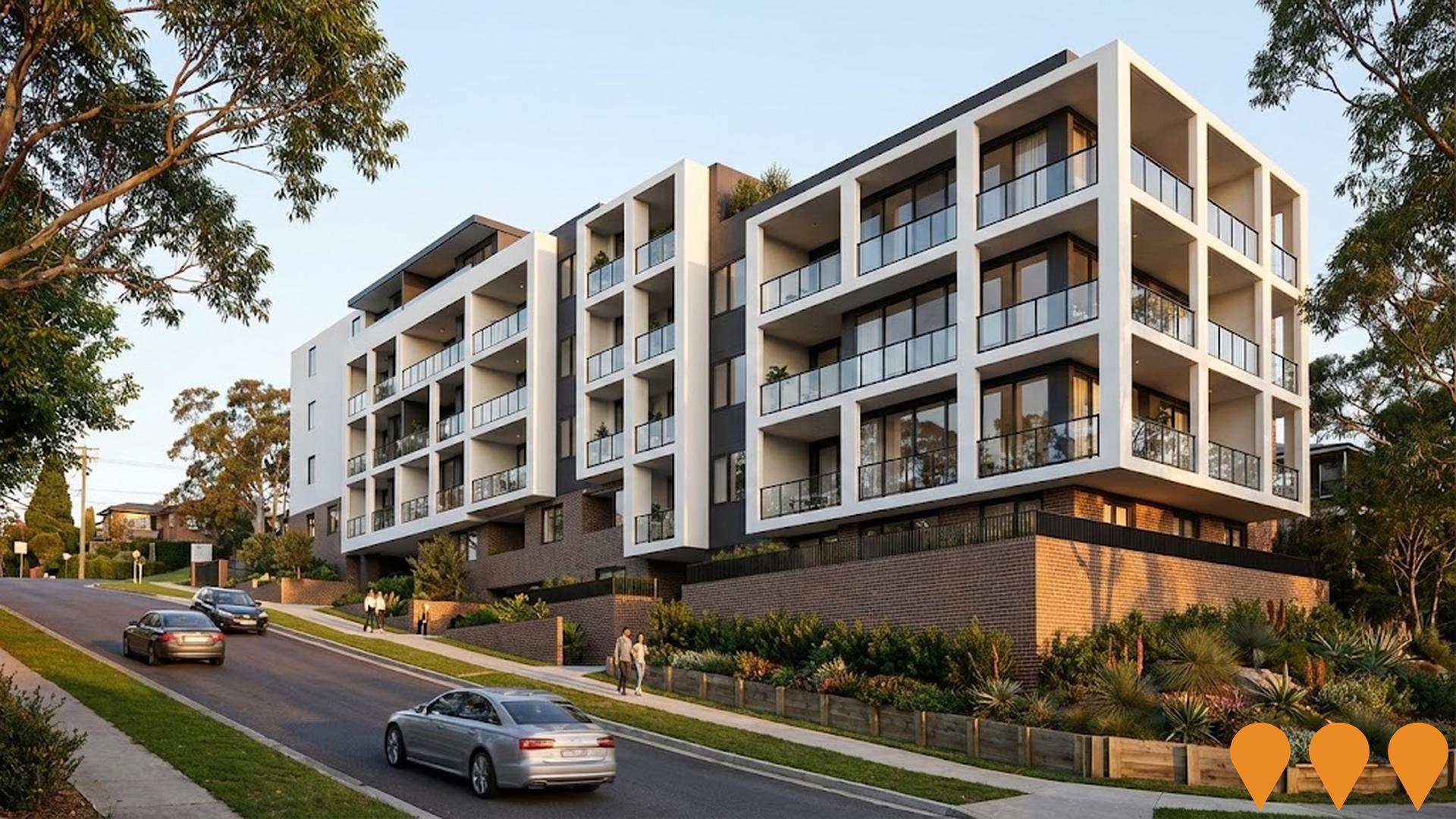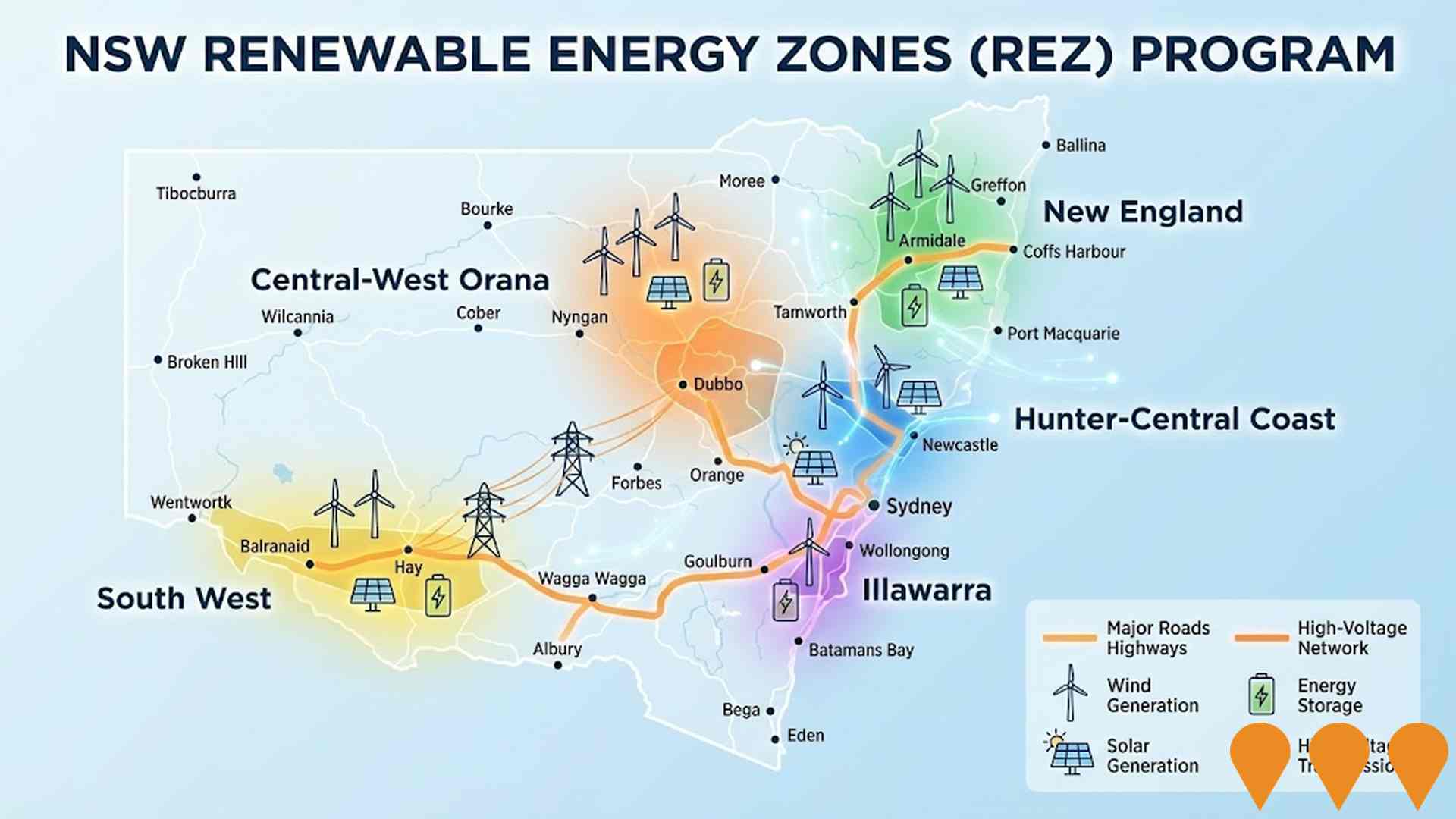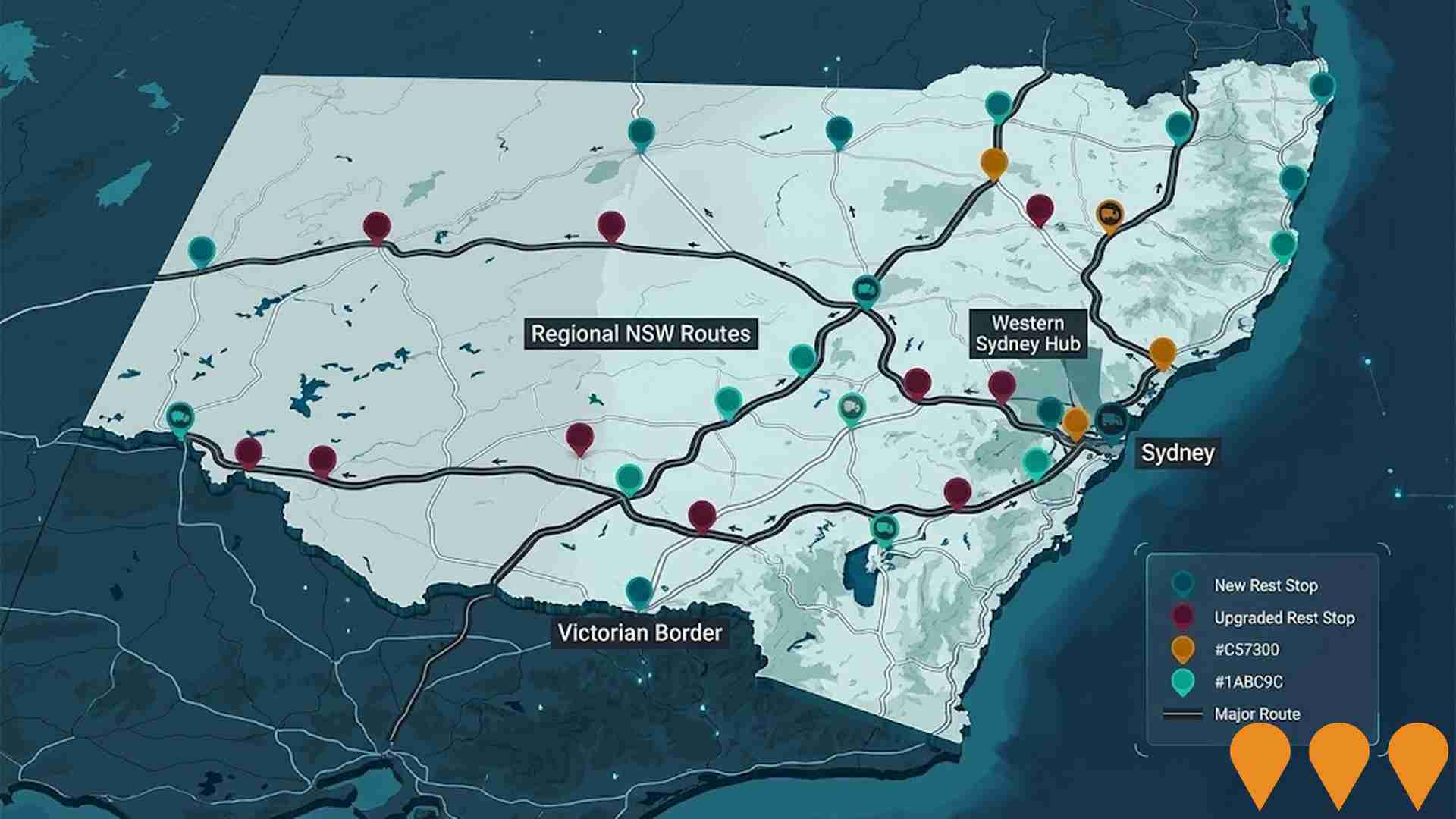Chart Color Schemes
est. as @ -- *
ABS ERP | -- people | --
2021 Census | -- people
Sales Activity
Curious about local property values? Filter the chart to assess the volume and appreciation (including resales) trends and regional comparisons, or scroll to the map below view this information at an individual property level.
Find a Recent Sale
Sales Detail
Population
Coonamble has shown very soft population growth performance across periods assessed by AreaSearch
Coonamble's population is around 4,103 as of November 2025. This reflects an increase of 177 people since the 2021 Census, which reported a population of 3,926 people. The change is inferred from the estimated resident population of 4,077 from the ABS as of June 2024 and an additional 16 validated new addresses since the Census date. This level of population equates to a density ratio of 0.30 persons per square kilometer. Coonamble's growth rate of 4.5% since the 2021 census exceeded that of its SA3 area (2.6%) and SA4 region, marking it as a growth leader in the region. Natural growth contributed approximately 78.3% of overall population gains during recent periods.
AreaSearch adopts ABS/Geoscience Australia projections for each SA2 area, released in 2024 with 2022 as the base year. For areas not covered by this data, AreaSearch utilises NSW State Government's SA2 level projections, released in 2022 with 2021 as the base year. Growth rates by age group from these aggregations are applied to all areas for years 2032 to 2041. Projections indicate a decline in overall population by 505 persons by 2041, but growth across specific age cohorts is anticipated, led by the 85 and over age group with a projected increase of 34 people.
Frequently Asked Questions - Population
Development
The level of residential development activity in Coonamble is very low in comparison to the average area assessed nationally by AreaSearch
Coonamble averaged approximately 6 new dwelling approvals annually over the past five financial years, totalling 31 homes. In fiscal year 26 to date, 3 approvals have been recorded. The area has experienced population decline, suggesting that new supply has likely kept pace with demand, offering buyers good choice while new properties are constructed at an average expected construction cost value of $364,000. This financial year has seen $6.2 million in commercial approvals registered, indicating limited focus on commercial development.
Relative to the Rest of NSW, Coonamble records somewhat elevated construction activity, with 16.0% above the regional average per person over the five-year period, preserving reasonable buyer options while sustaining existing property demand. This activity is lower than the national average, reflecting market maturity and possible development constraints. New development consists of 60.0% standalone homes and 40.0% townhouses or apartments, expanding the range of medium-density options and creating a mix of opportunities across price brackets. This represents a notable shift from the area's existing housing composition, currently at 95.0% houses, indicating decreasing availability of developable sites and reflecting changing lifestyles and the need for more diverse, affordable housing options. The estimated population per dwelling approval is 661 people, reflecting Coonamble's quiet, low activity development environment.
Given stable or declining population forecasts, Coonamble may experience less housing pressure, creating favourable conditions for buyers.
Frequently Asked Questions - Development
Infrastructure
Coonamble has limited levels of nearby infrastructure activity, ranking in the 16thth percentile nationally
Changes to local infrastructure significantly impact an area's performance. AreaSearch has identified four projects that could affect this region: Inland Rail from Narromine to Narrabri, Macquarie-Castlereagh Alluvium Water Resource Plan, Aero Park Residential Estate, and Castlereagh Country Regional Drought Resilience Plan. The following list details those most relevant.
Professional plan users can use the search below to filter and access additional projects.
INFRASTRUCTURE SEARCH
 Denotes AI-based impression for illustrative purposes only, not to be taken as definitive under any circumstances. Please follow links and conduct other investigations from the project's source for actual imagery. Developers and project owners wishing us to use original imagery please Contact Us and we will do so.
Denotes AI-based impression for illustrative purposes only, not to be taken as definitive under any circumstances. Please follow links and conduct other investigations from the project's source for actual imagery. Developers and project owners wishing us to use original imagery please Contact Us and we will do so.
Frequently Asked Questions - Infrastructure
Central-West Orana Renewable Energy Zone (REZ) Transmission Project
Australia's first coordinated Renewable Energy Zone transmission project. Delivers new 500 kV and 330 kV lines, energy hubs and substations across approximately 20,000 km2 in central-west NSW. ACEREZ consortium (Acciona, Cobra, Endeavour Energy) appointed as the Network Operator for design, construction, financing, operation and maintenance over 35 years. Initial network capacity of 4.5 GW, expanding to 6 GW by 2038. Construction commenced June 2025, with staged commissioning from 2027 and full operations targeted for 2028-2029. Project reached financial close in April 2025.

Central-West Orana Renewable Energy Zone
NSW's first Renewable Energy Zone, a 20,000 sq km area centered around Dubbo and Dunedoo. The project involves a new high voltage transmission network and energy hubs, unlocking at least 4.5 GW of network capacity for up to 7.7 GW of renewable generation and storage projects. The project received NSW planning approval in June 2024, with construction continuing through to 2030. It is expected to power around 2 million homes, generate an estimated $20 billion in private investment, and support around 5,000 construction jobs at its peak.

Low and Mid-Rise Housing Policy
State-wide NSW planning reforms via amendments to the State Environmental Planning Policy to enable more diverse low and mid-rise housing (dual occupancies, terraces, townhouses, manor houses and residential flat buildings up to 6 storeys) in well-located areas within 800 m of selected train, metro and light-rail stations and town centres. Stage 1 (dual occupancies in R2 zones statewide) commenced 1 July 2024. Stage 2 (mid-rise apartments, terraces and dual occupancies near stations) commenced 28 February 2025. Expected to facilitate up to 112,000 additional homes over the next five years.

NSW Renewable Energy Zones (REZ) Program
NSW is delivering five Renewable Energy Zones (Central-West Orana, New England, South West, Hunter-Central Coast and Illawarra) to coordinate new wind and solar generation, storage and high-voltage transmission. The program is led by EnergyCo NSW under the Electricity Infrastructure Roadmap. Construction of the first REZ (Central-West Orana) transmission project commenced in June 2025, with staged energisation from 2028. Across the program, NSW targets at least 12 GW of new renewable generation and 2 GW of long-duration storage by 2030.

Inland Rail - Narromine to Narrabri
The Narromine to Narrabri section is the longest segment of the Inland Rail project, comprising approximately 306km of new single-track greenfield rail corridor in north-western New South Wales. It connects the completed Parkes to Narromine section with the Narrabri to North Star section (under construction). Designed for 1,800m double-stacked freight trains, key features include seven crossing loops (up to 2.2km long), 75 new bridges and viaducts, 49 new public level crossings, millions of cubic metres of earthworks, thousands of concrete culvert drains, road realignments, and utility relocations. The project received NSW Government approval in February 2023 and Australian Government EPBC approval in January 2024. As of November 2025, the project remains in planning and preparation with ongoing field investigations (geotechnical, biodiversity, cultural heritage), design refinement, and landowner consultations; construction has not yet commenced.

Aero Park Residential Estate
Aero Park Residential Estate is a council-led house and land subdivision on the north western fringe of Gilgandra. The approved estate comprises 57 residential lots, with stage 1 delivering 34 fully serviced lots and 5 earlier lots already developed along Farrar Street. Lots are generally between about 1,242 m2 and 1,897 m2, with services including water, sewer, NBN and underground power, new roads, footpaths and solar street lighting. Council has completed the stage 1 civil works and is now selling lots through local agents to increase housing supply and support growth linked to Inland Rail and regional renewable energy projects.

NSW Heavy Vehicle Rest Stops Program (TfNSW)
Statewide Transport for NSW program to increase and upgrade heavy vehicle rest stopping across NSW. Works include minor upgrades under the $11.9m Heavy Vehicle Rest Stop Minor Works Program (e.g. new green reflector sites and amenity/signage improvements), early works on new and upgraded formal rest areas in regional NSW, and planning and site confirmation for a major new dedicated rest area in Western Sydney. The program aims to reduce fatigue, improve safety and productivity on key freight routes, and respond to industry feedback collected since 2022.

Queensland New South Wales Interconnector
The proposed Queensland New South Wales Interconnector (QNI Connect) aims to link New England's power to Queensland over approx. 600km, enhancing network capacity by up to 1,700 MW, with anticipated completion by FY2030-31.

Employment
The labour market performance in Coonamble lags significantly behind most other regions nationally
Coonamble has a balanced workforce comprising white and blue collar jobs, with essential services well represented. Its unemployment rate is 5.5%.
As of June 2025, the town has 1,659 residents employed, an unemployment rate of 7.3% (compared to Rest of NSW's 3.7%), and a workforce participation rate of 52.4% (versus Rest of NSW's 56.4%). Key employment sectors include agriculture, forestry & fishing, health care & social assistance, and education & training. Coonamble specializes in agriculture, forestry & fishing, with an employment share 5.8 times the regional level. Conversely, manufacturing is under-represented at 1.0% compared to Rest of NSW's 5.8%.
The area may offer limited local employment opportunities, as shown by the Census working population versus resident population count. Between June 2024 and June 2025, Coonamble's labour force decreased by 1.8%, while employment declined by 3.9%, leading to a 2.1 percentage point rise in unemployment. In contrast, Rest of NSW saw employment fall by 0.1%, the labour force expand by 0.3%, and unemployment rise by 0.4 percentage points. Jobs and Skills Australia's national employment forecasts from May 2025 project overall employment growth of 6.6% over five years and 13.7% over ten years. Applying these projections to Coonamble's employment mix suggests local growth of approximately 5.5% over five years and 12.1% over ten years, assuming constant population projections for illustrative purposes.
Frequently Asked Questions - Employment
Income
The area's income levels rank in the lower 15% nationally based on AreaSearch comparative data
AreaSearch's latest postcode level ATO data for financial year 2022 shows Coonamble had a median income among taxpayers of $43,964 and an average of $62,322. These figures are slightly lower than the national averages. Compared to Rest of NSW, Coonamble's median is $49,459 and average is $62,998. Based on Wage Price Index growth of 12.61% since financial year 2022, estimated incomes as of September 2025 would be approximately $49,508 (median) and $70,181 (average). Census 2021 income data places Coonamble's household, family, and personal incomes between the 18th and 24th percentiles nationally. The dominant income bracket is $1,500 - 2,999 with 28.4% of residents (1,165 people), similar to surrounding regions at 29.9%. Housing costs are modest, with 91.1% of income retained, but total disposable income ranks at the 26th percentile nationally.
Frequently Asked Questions - Income
Housing
Coonamble is characterized by a predominantly suburban housing profile, with above-average rates of outright home ownership
The dwelling structure in Coonamble, as per the latest Census, consisted of 94.9% houses and 5.1% other dwellings (semi-detached, apartments, 'other' dwellings), compared to Non-Metro NSW's 90.0% houses and 10.0% other dwellings. Home ownership in Coonamble stood at 42.4%, with mortgaged dwellings at 25.3% and rented ones at 32.3%. The median monthly mortgage repayment was $867, below Non-Metro NSW's average of $1,000. Weekly rent in Coonamble was recorded at $190, compared to Non-Metro NSW's $180. Nationally, Coonamble's mortgage repayments were significantly lower than the Australian average of $1,863, and rents were substantially below the national figure of $375.
Frequently Asked Questions - Housing
Household Composition
Coonamble features high concentrations of lone person households, with a higher-than-average median household size
Family households constitute 65.6% of all households, composed of 22.5% couples with children, 25.9% couples without children, and 15.6% single parent families. Non-family households account for the remaining 34.4%, with lone person households at 31.3% and group households comprising 3.5%. The median household size is 2.4 people, larger than the Rest of NSW average of 2.3.
Frequently Asked Questions - Households
Local Schools & Education
Coonamble faces educational challenges, with performance metrics placing it in the bottom quartile of areas assessed nationally
The area's university qualification rate is 16.2%, significantly lower than the NSW average of 32.2%. Bachelor degrees are most common at 12.8%, followed by postgraduate qualifications (2.1%) and graduate diplomas (1.3%). Vocational credentials are prevalent, with 35.6% of residents aged 15+ holding them, including advanced diplomas (8.2%) and certificates (27.4%). Educational participation is high at 32.2%, with 13.7% in primary, 9.3% in secondary, and 2.9% in tertiary education.
Coonamble has 5 schools with a combined enrollment of 666 students. The educational mix includes 3 primary, 1 secondary, and 1 K-12 school.
Frequently Asked Questions - Education
Schools Detail
Nearby Services & Amenities
Transport
Transport servicing is low compared to other areas nationally based on assessment of service frequency, route connectivity and accessibility
Coonamble has 173 active public transport stops, offering a mix of train and bus services. These are served by 19 individual routes, which together provide 185 weekly passenger trips. The average distance from residents to the nearest stop is 157 meters, indicating excellent accessibility.
Service frequency averages 26 trips per day across all routes, equating to approximately one trip per week for each stop.
Frequently Asked Questions - Transport
Transport Stops Detail
Health
Health performance in Coonamble is well below average with prevalence of common health conditions notable across both younger and older age cohorts
Health data indicates significant health challenges in Coonamble, with common conditions prevalent across both younger and older age groups.
Private health cover stands at approximately 51% of the total population (~2,096 people), slightly lower than the average SA2 area. Asthma and arthritis are the most common medical conditions, affecting 11.3% and 8.9% of residents respectively. About 62.7% of residents report no medical ailments, compared to 65.9% in Rest of NSW. Coonamble has 18.2% of residents aged 65 and over (747 people), lower than the 20.2% in Rest of NSW. Health outcomes among seniors present some challenges, largely mirroring those of the general population.
Frequently Asked Questions - Health
Cultural Diversity
The latest Census data sees Coonamble placing among the least culturally diverse areas in the country when compared across a range of language and cultural background related metrics
Coonamble's cultural diversity was below average. Its population comprised 84.7% citizens, with 96.2% born in Australia and 97.6% speaking English at home. Christianity was the dominant religion, practiced by 73.9%, compared to 67.2% across Rest of NSW.
The top three ancestry groups were Australian (32.4%), English (24.4%), and Australian Aboriginal (22.1%).
Frequently Asked Questions - Diversity
Age
Coonamble's population is slightly younger than the national pattern
The median age in Coonamble is 37 years, which is lower than Rest of NSW's average of 43 years and close to Australia's national average of 38 years. The age profile shows that the 0-4 year-olds comprise 8.9% of the population, while the 65-74 year-old group makes up 9.6%. Between 2021 and present, the percentage of people aged 15 to 24 has increased from 10.6% to 12.1%, while the 45 to 54 age group has decreased from 11.6% to 10.0%, and the 25 to 34 age group has dropped from 12.5% to 11.4%. By 2041, demographic projections show that the 85+ age cohort is expected to increase by 25 people (27%), from 93 to 119. The combined 65+ age groups are projected to account for 96% of total population growth. Conversely, the 75-84 and 35-44 age cohorts are expected to experience population declines.


